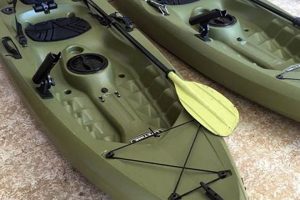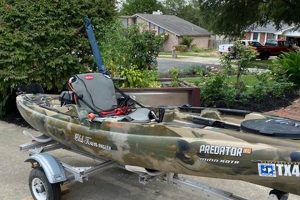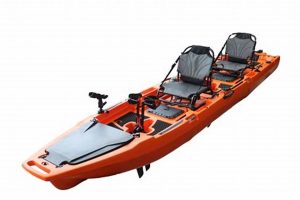Budget-friendly kayaks offer an accessible entry point to paddlesports. This market segment typically includes recreational kayaks constructed from durable, yet cost-effective materials like high-density polyethylene. These kayaks are often simpler in design, focusing on stability and ease of use, making them suitable for calm waters like lakes and slow-moving rivers. Examples include shorter recreational kayaks, sit-on-top models, and inflatable kayaks. Used kayaks also fall into this category, offering potential savings for paddlers willing to consider pre-owned options.
Affordable paddling options contribute significantly to the growth and accessibility of watersports. Lowering the financial barrier allows a broader range of individuals to experience the physical and mental health benefits of kayaking, from leisurely paddling to exploring nature. Historically, kayak ownership has been associated with a higher price point, potentially limiting participation. The increasing availability of less expensive options democratizes the sport, fostering wider engagement and appreciation for aquatic environments.
Exploring the nuances of selecting an appropriate kayak within a budget requires careful consideration of several factors. The subsequent sections will delve into topics such as construction materials, kayak types, features, and reputable retailers, equipping readers with the knowledge necessary to make informed purchasing decisions.
Tips for Finding Affordable Kayaks
Acquiring a kayak without exceeding a budget requires careful planning and informed decision-making. The following tips offer guidance for navigating the market effectively.
Tip 1: Consider Used Kayaks: Exploring the used kayak market can yield significant savings. Checking online marketplaces, local classifieds, and consignment shops can uncover well-maintained kayaks at reduced prices. Thorough inspection for damage is crucial before purchase.
Tip 2: Research Different Kayak Types: Kayak prices vary depending on type and features. Recreational kayaks generally offer the most budget-friendly options. Inflatable kayaks provide portability and storage advantages at lower price points, while fishing kayaks or touring kayaks often command higher prices due to specialized features.
Tip 3: Compare Prices Across Retailers: Diligently comparing prices across various retailers, both online and brick-and-mortar stores, ensures the best possible deal. Seasonal sales and clearances present opportunities for additional discounts.
Tip 4: Prioritize Essential Features: Focus on essential features rather than premium add-ons to manage costs. Consider basic seating, storage, and stability features as priorities over higher-end materials or advanced features like rudder systems.
Tip 5: Check for Package Deals: Some retailers offer package deals that include paddles, life vests, and other essential accessories along with the kayak, potentially offering cost savings compared to purchasing items separately.
Tip 6: Inspect Thoroughly Before Purchasing: Whether buying new or used, careful inspection for any damage, defects, or wear is crucial. For used kayaks, particular attention should be paid to the hull, seams, and any signs of previous repairs.
By adhering to these guidelines, individuals can locate a suitable kayak that aligns with both budgetary constraints and paddling aspirations. Careful research, comparison shopping, and a focus on essential needs contribute to a satisfying and cost-effective purchase.
Ultimately, finding an affordable kayak allows broader access to the rewarding experience of paddlesports. The next section offers concluding thoughts and encourages readers to embark on their paddling journey.
1. Type
Kayak type significantly influences price, representing a crucial factor when searching for affordable options. Understanding the various types and their associated cost implications is essential for informed purchasing decisions.
- Recreational Kayaks
Recreational kayaks are generally the most budget-friendly type. Designed for calm waters, they prioritize stability and ease of use. Simpler designs and construction contribute to lower manufacturing costs, making them an accessible entry point for new paddlers. Examples include sit-on-top and shorter sit-inside models ideal for leisurely paddling on lakes and slow-moving rivers.
- Inflatable Kayaks
Inflatable kayaks offer portability and storage advantages, often at lower price points than rigid kayaks. While some high-end inflatable models exist, many budget-friendly options cater to recreational use. Their compact nature reduces storage space requirements and transportation costs. However, durability and performance can be considerations compared to hard-shell kayaks.
- Fishing Kayaks
Fishing kayaks typically include specialized features like rod holders, gear tracks, and live wells. These added features generally increase the price compared to recreational kayaks. While budget-friendly fishing kayaks are available, they may offer fewer specialized features or utilize less expensive materials. Anglers seeking premium features often invest more.
- Touring Kayaks
Touring kayaks, designed for longer journeys and open water, prioritize tracking, speed, and storage capacity. Their longer length, specialized hull designs, and higher-quality materials often translate to higher prices. Finding affordable touring kayaks typically involves considering older models or used options.
Selecting the right kayak type requires balancing budget constraints with paddling needs. While recreational and inflatable kayaks often provide the most affordable entry point, specialized types like fishing or touring kayaks usually require a greater financial investment. Careful consideration of intended use and desired features is essential for maximizing value and finding the best fit within a budget.
2. Material
Kayak construction material directly impacts both cost and performance. Understanding the properties and price points of various materials is essential for finding a balance between affordability and durability when seeking budget-friendly kayaks. Material selection influences not only the initial purchase price but also long-term maintenance and repair costs.
- Polyethylene (HDPE)
High-density polyethylene (HDPE) is the most common material for affordable kayaks. Its durability, impact resistance, and UV resistance make it suitable for recreational use. HDPE kayaks can withstand minor impacts and sun exposure without significant damage, contributing to their longevity. Rotational molding, a cost-effective manufacturing process, further contributes to the affordability of HDPE kayaks.
- Fiberglass
Fiberglass kayaks offer superior performance characteristics compared to HDPE, including lighter weight, greater stiffness, and improved speed. However, fiberglass construction typically comes at a higher price point. Fiberglass kayaks require more careful handling and maintenance due to their susceptibility to scratches and cracks. While less common in the budget-friendly market segment, used fiberglass kayaks can sometimes offer value for experienced paddlers.
- Inflatable Materials (PVC, Hypalon, Nitrylon)
Inflatable kayaks utilize various materials, often including polyvinyl chloride (PVC), Hypalon, or Nitrylon. PVC offers a budget-friendly option, while Hypalon and Nitrylon provide increased durability and resistance to abrasion and UV degradation, typically at a higher cost. Material selection influences the inflatable kayak’s lifespan, puncture resistance, and overall performance.
- Composite Materials (Carbon Fiber, Kevlar)
Composite materials like carbon fiber and Kevlar offer the highest performance in terms of weight, stiffness, and speed. However, these materials are significantly more expensive than HDPE or fiberglass, placing them outside the typical budget-friendly range. Composite kayaks are generally reserved for high-performance paddling and racing, requiring specialized care and maintenance.
Material selection significantly influences the price of a kayak. While HDPE provides a durable and affordable option for recreational use, other materials like fiberglass and inflatable fabrics offer different performance characteristics at varying price points. Prioritizing essential features and selecting a material appropriate for intended use ensures a cost-effective and satisfying purchase.
3. Condition
Condition significantly influences the price of a kayak, especially within the “kayaks for sale cheap” market segment. Assessing a kayak’s condition is crucial for determining its value and ensuring a worthwhile investment. Careful inspection and consideration of various factors help buyers make informed decisions and potentially secure significant savings.
- Used Kayaks
Used kayaks represent a significant portion of the affordable kayak market. Condition varies widely, from lightly used models in near-perfect condition to kayaks requiring repairs. Scratches, dents, and fading are common in used kayaks and may not significantly impact performance. However, deeper cracks, structural damage, or significant wear can compromise safety and require costly repairs. Thorough inspection and price negotiation are essential when considering used kayaks.
- New Kayaks on Sale
Retailers often offer discounts on new kayaks due to overstock, discontinued models, or seasonal sales. These kayaks are typically in excellent condition, offering potential savings without the risks associated with used kayaks. Checking for minor cosmetic imperfections, which may justify further price reductions, is advisable.
- Damaged or Repaired Kayaks
Kayaks with prior damage or repairs can be significantly cheaper, but require careful evaluation. Understanding the extent of the damage, the quality of the repairs, and the potential impact on performance is crucial. Minor repairs, if professionally executed, may not significantly affect usability. However, significant structural damage can compromise safety and should be avoided.
- Demo or Rental Kayaks
Demo or rental kayaks, previously used by customers or for demonstrations, are often sold at discounted prices. While generally well-maintained, these kayaks may exhibit signs of wear and tear. Inspecting for damage, assessing the overall condition, and comparing prices with new models helps determine their value proposition.
A kayak’s condition directly correlates with its price. While superficial imperfections are acceptable in budget-friendly options, structural damage should be avoided. Thorough inspection, informed assessment, and comparison shopping empowers buyers to find well-priced kayaks without compromising safety or performance. The condition evaluation plays a pivotal role in maximizing value and ensuring a satisfactory purchase within the “kayaks for sale cheap” segment.
4. Features
Features play a significant role in determining a kayak’s price and suitability for different paddling activities. Within the “kayaks for sale cheap” market, features often differentiate basic recreational models from more specialized kayaks. Understanding the impact of various features on cost and functionality empowers informed purchase decisions.
- Seating and Comfort
Basic seating systems, often molded into the kayak’s hull, are standard in affordable recreational kayaks. Adjustable backrests and padded seats enhance comfort but typically increase cost. Higher-end features like adjustable foot braces and thigh supports are less common in budget-friendly models. Evaluating comfort features based on intended paddling duration and personal preferences balances cost and comfort.
- Storage Capacity
Storage options vary significantly across kayak types and price points. Basic recreational kayaks typically include small storage hatches or bungee cords for securing gear. Larger storage compartments, dry hatches, and integrated storage systems enhance convenience and capacity but often come at a premium. Assessing storage needs based on planned activities and gear requirements informs feature selection within a budget.
- Rudder and Tracking Systems
Rudders and skegs assist with tracking and maneuverability, particularly in windy conditions or open water. These features are less common in budget-friendly recreational kayaks, often reserved for touring or sea kayaks. While rudders enhance performance, they add complexity and cost. Prioritizing stability and maneuverability needs based on paddling environment and experience level guides feature selection.
- Fishing-Specific Features
Fishing kayaks often include specialized features like rod holders, gear tracks, and live wells. While some affordable fishing kayaks incorporate basic rod holders, more advanced features like adjustable rod mounts and integrated fish finders typically increase cost. Balancing fishing needs with budgetary constraints requires prioritizing essential features over premium add-ons.
Feature selection significantly influences the overall cost of a kayak. Within the “kayaks for sale cheap” market, prioritizing essential features over premium add-ons allows paddlers to find suitable kayaks without exceeding budget constraints. Careful consideration of intended use, paddling environment, and comfort requirements ensures a balanced approach to feature selection and maximizes value within the affordable kayak segment.
5. Retailer
Retailer selection significantly impacts the acquisition of budget-friendly kayaks. Retailers represent the primary access point to these products, influencing price, availability, and purchasing experience. The retailer landscape encompasses a spectrum from large national chains to small local shops, each offering distinct advantages and disadvantages. Understanding the retail landscape is essential for effectively navigating the market and securing the best possible value.
Large retailers, such as sporting goods chains or online marketplaces, often offer a wider selection of kayaks and competitive pricing due to economies of scale. However, personalized service and specialized expertise may be limited. Smaller, local retailers often provide expert advice, tailored service, and potential opportunities for negotiation or trade-ins. Their focus on paddling sports can offer valuable insights and support for novice kayakers. Online retailers expand purchasing options beyond geographical limitations, facilitating price comparison and access to specialized brands. However, online purchases preclude in-person inspection and may involve shipping costs.
Effective retailer selection requires careful consideration of individual needs and priorities. Factors such as desired kayak type, budget constraints, and the importance of personalized service guide the decision-making process. Leveraging online resources for price comparison, product reviews, and retailer reputation enhances purchasing power. Thorough research and strategic retailer selection optimize the acquisition process, maximizing the potential for finding high-quality, affordable kayaks. Ultimately, the retailer serves as a crucial link between manufacturers and consumers within the budget-conscious paddling community.
Frequently Asked Questions
This section addresses common inquiries regarding the acquisition of budget-friendly kayaks. Understanding these key considerations facilitates informed decision-making and enhances the overall purchasing experience.
Question 1: What is the typical price range for a cheap kayak?
Prices vary significantly depending on type, material, features, and condition. Generally, inexpensive kayaks range from $200 to $500. Used kayaks often fall within the lower end of this spectrum, while new recreational kayaks typically occupy the higher end.
Question 2: Are cheap kayaks durable enough for regular use?
Durability depends on construction material and manufacturing quality. Many affordable kayaks utilize durable high-density polyethylene (HDPE), suitable for recreational use in calm waters. Proper care and maintenance contribute to longevity.
Question 3: What are the trade-offs when purchasing a less expensive kayak?
Potential trade-offs may include fewer features, basic seating, less storage capacity, and potentially heavier weight compared to higher-end models. Performance characteristics, such as speed and tracking, might also differ.
Question 4: Where can one find kayaks for sale at lower prices?
Potential sources include online marketplaces, local classifieds, used sporting goods stores, and seasonal sales at retail outlets. Comparing prices across multiple vendors is recommended.
Question 5: What essential features should one prioritize in a budget-friendly kayak?
Essential features include stability, comfortable seating, adequate storage for essential gear, and durable construction materials. Prioritizing needs over premium add-ons helps manage costs.
Question 6: How can one determine the condition of a used kayak?
Thorough inspection is crucial. Examine the hull for cracks, dents, or repairs. Check the condition of the seats, hatches, and any included accessories. Inquire about the kayak’s usage history and any previous damage.
Careful consideration of these factors enables informed purchasing decisions within the budget-friendly kayak market. Balancing cost and quality ensures a satisfying paddling experience.
This concludes the frequently asked questions section. Readers are encouraged to proceed to the next section for concluding remarks.
Conclusion
Locating budget-friendly kayaks requires careful consideration of various factors. Balancing cost and quality necessitates evaluating kayak type, construction material, condition, essential features, and retailer selection. Prioritizing needs over premium add-ons ensures a cost-effective purchase without compromising functionality or safety. Thorough research, including price comparison and condition assessment, empowers informed decision-making within the affordable kayak market.
Affordable access to paddlesports fosters broader participation and appreciation for aquatic environments. The availability of budget-friendly kayaks enables individuals to experience the physical and mental health benefits of kayaking without significant financial barriers. Continued market growth and innovation within the affordable kayak segment promise expanded opportunities for individuals seeking accessible entry points to the rewarding realm of paddlesports.






